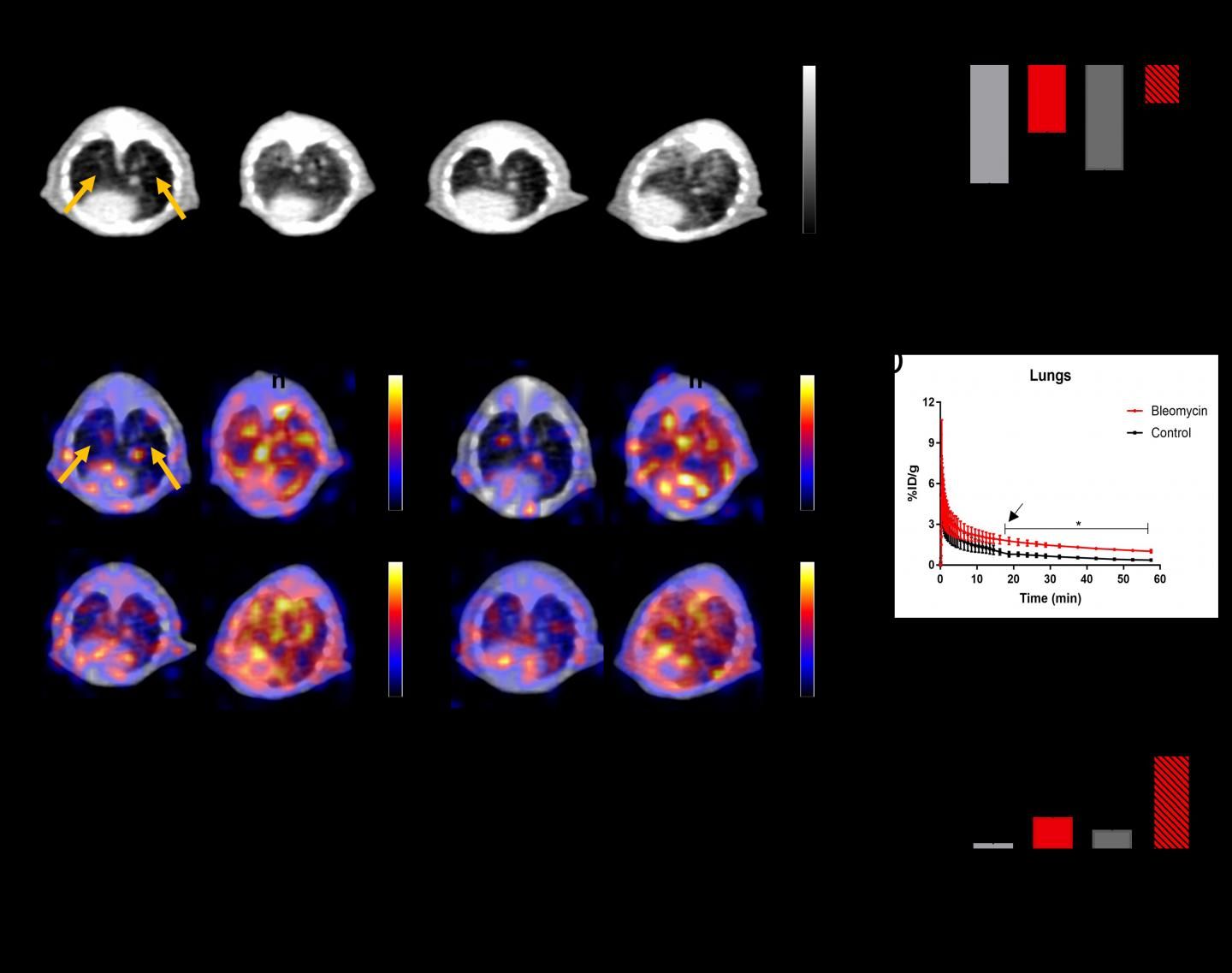PET Radiotracer Can Detect, Assess Lung Fibrosis
Use enables direct imaging of disease process.
Using a specific radiotracer with PET imaging gives providers a non-invasive method to pinpoint and monitor pulmonary fibrosis, according to new research.
In a poster presented during the Society of Nuclear Medicine and Molecular Imaging 2021 Annual Meeting, researchers from the University of Wisconsin-Madison showed that by binding to activated fibroblasts in affected lungs, 68Ga-labeled fibroblast activation protein inhibitor (FAPI) enables direct imaging of the disease process with PET.
For more SNMMI 2021 coverage, click here.
Idiopathic pulmonary fibrosis (IPF) makes breathing difficult by extensively scarring the lungs. Every year, it accounts for more than 40,000 deaths in the United States. Consequently, having a better, more specific method to diagnose affected patients could improve their overall management.
A) Axial CT images through the mouse lungs at 7 and 14 days after intratracheal administration of bleomycin or saline (as a control), demonstrating increased lung fibrosis in the bleomycin group (white arrows). (B) CT attenuation histograms in Hounsfield units (HU) after lung segmentation demonstrate increased attenuation in the lungs in the bleomycin group than the control group (p <0.05), consistent with increasing fibrosis (n=3). (C) Representative axial PET/CT fusion images at 20 and 60 min demonstrating increased FAPI uptake in the lungs of the bleomycin group (white arrows) with no significant uptake in the control group (yellow arrows). (D) Time-activity curve of lung uptake ROI analysis demonstrating higher FAPI uptake in the lungs of the bleomycin group than the control (p < 0.05), 14 days after bleomycin (n=3). (E) Ex vivo biodistribution data of lung tissue demonstrating higher radiotracer uptake in the lungs of the bleomycin group than the control (n=3). *p<0.05, **p<0.01.
Credit: Image created by CA Ferreira et al., University of Wisconsin-Madison, Madison, WI.

“CT scans can provide physicians with information on anatomic features and other effects of IPF, but not its current state of activity,” said Carolina de Aguiar Ferreira, Ph.D., a research associated at the University of Wisconsin-Madison. “We sought to identify and image a direct non-invasive biomarker for early detection, disease monitoring, and accurate assessment of treatment response.”
Fibroblast activation protein (FAP) is over-expressed in IPF, making it a good target as a potential biomarker, the team said. For their study, the induced pulmonary fibrosis into one group of mice and used another group as a control. They scanned both cohorts with the FAPI-based PET/CT 68Ga-FAPI-46 across several time points. When compared, the mice with induced pulmonary fibrosis had a much higher uptake of the radiotracer. This result allowed the investigators to successfully pinpoint and assess areas of the lungs affected by IPF.
But there is still more work to be done, they said.
“Further validation of 68Ga-FAPI-46 for the detection and monitoring of pulmonary fibrosis would make this molecular imaging tool the first technique for early, direct, and non-invasive detection of disease,” they said. “It would also provide an opportunity for molecular imaging to reduce the frequency of lung biopsies, which carry their own inherent risks.”
These findings, she added, show that functional imaging can play a vital role in evaluating the disease process.
For more coverage based on industry expert insights and research, subscribe to the Diagnostic Imaging e-Newsletter here.
GE HealthCare Debuts AI-Powered Cardiac CT Device at ACC Conference
April 1st 2025Featuring enhanced low-dose image quality with motion-free images, the Revolution Vibe CT system reportedly facilitates improved diagnostic clarity for patients with conditions ranging from in-stent restenosis to atrial fibrillation.
The Reading Room: Racial and Ethnic Minorities, Cancer Screenings, and COVID-19
November 3rd 2020In this podcast episode, Dr. Shalom Kalnicki, from Montefiore and Albert Einstein College of Medicine, discusses the disparities minority patients face with cancer screenings and what can be done to increase access during the pandemic.
Can Photon-Counting CT be an Alternative to MRI for Assessing Liver Fat Fraction?
March 21st 2025Photon-counting CT fat fraction evaluation offered a maximum sensitivity of 81 percent for detecting steatosis and had a 91 percent ICC agreement with MRI proton density fat fraction assessment, according to new prospective research.